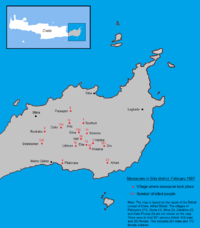Lasithi massacres
| Lasithi massacres | |
|---|---|
| Part of the Cretan Revolt of 1897 | |
|
Area where massacres took place. | |
| Location | Crete, Ottoman Empire |
| Date | 1897 |
| Target | Cretan Muslims |
Attack type | Massacre |
| Deaths | 850[1] -1,000[2] |
The Lasithi massacres was a massacre of Muslim civilians in 1897. They took place in the Lasithi region of eastern Crete. Over 850[1] or around 1,000 people were murdered.[2]
Backgroundy
The Ottoman Empire had conquered Crete in the 17th century and as a consequence a large part of the local Christian population had converted to Islam.[3] Following the Greek Revolution in 1821 there was continuing violence between the two religious communities.[3] The Christians demanded the island's unification with Greece which the local Muslims opposed. Tensions remained high and in 1896 a violent conflict broke out which led to the landing of a Greek army on the island.[4] Rumours of a massacre reached the Western consuls who ordered an investigation. However the first investigation was covered up, most of the investigators were local Christian Greeks. After some time a second investigation by British consul Alfred Biliotti confirmed the events.[2]
Massacre
The massacres took place during February 1897, when local Muslim civilians were murdered by the local Christians. At some places they tried to defend themselves. A number of Muslims was saved by friendly Christians. The surviving Muslims fled the areas, some 4,000 became refugees and very few returned to their homes again.[2] Most of their lands and property had been taken over or destroyed. According to the British consul Sir Alfred Biliotti, 851 people were killed this included 201 male and 173 female children.[5] Archaeologist Arthur Evans. who had been in Crete for some years. returned in 1898 as a reporter for the Manchester Guardian he wrote:
But the most deliberate act of extermination was that perpetrated at Eteà. In this small village, too, the Moslem inhabitants, including the women and children, had taken refuge in the mosque, which the men defended for a while. The building itself is a solid structure, but the door of the small walled enclosure... was finally blown in, and the defenders laid down their arms, understanding, it would appear, that their lives were to be spared. Men, women and children, they were all led forth to the church of St. Sophia, which lies on a hill about half an hour above the village, and then and there dispatched—the men cut to pieces, the women and children shot. A young girl who had fainted, and was left for dead, alone lived to tell the tale.[6]
Aftermath
The conflict in the island continued. There was an attack of local Muslims and Ottoman soldiers on Christians and British troops in Candia. After this event Ottoman troops were forced to leave the island and it was made an autonomous state under the supervision of the Great Powers. Alarmed by the events in Lasithi, Biliotti organized the evacuation of the local Muslims and Ottoman troops in Kandanos. They had been besieged by Christian rebels and they could suffer the same fate. Biliotti led an expedition and after the Muslims were looted of their possessions they were allowed to be evacuated under escort of allied troops. Some time later Biliotti unsuccessfully tried to make an arrangement to restore the Muslims of Lasithi their lost property and land.[1] After some time some British newspapers claimed that the massacres were false, Biliotti and Admiral Harris knew that they took place and replied to the newspapers.[2] The Cretan Muslims emigrated from the island in later years and in 1908 the island became unified with Greece.
List of victims according to Biliotti[5][7]
| Village | Male | Female | Total |
|---|---|---|---|
| Daphne | 82 | 74 | 156 |
| Sikia | 63 | 81 | 144 |
| Stravodoxari | 55 | 53 | 108 |
| Ethia | 43 | 33 | 76 |
| Paliopetsi | 34 | 37 | 71 |
| Ziro | 59 | 42 | 101 |
| Ahladis | 34 | 9 | 43 |
| Arinama | 21 | 21 | 42 |
| Vari | 17 | 19 | 36 |
| Zakatlios | 3 | 3 | |
| Kria | 10 | 5 | 15 |
| Paraspori | 4 | 4 | |
| Roukaka | 7 | 1 | 8 |
| Lithines | 5 | 5 | 10 |
| Handra | 1 | 1 | 2 |
| Gonia | 1 | 1 | |
| Mina | 2 | 3 | 5 |
| Sklavios | 11 | 4 | 15 |
| Kata Pisropi | 3 | 3 | 6 |
| Pilalimata | 2 | 2 | 4 |
| Tourtolous | 1 | 1 | |
| Total | 458 | 393 | 851 |
Sources
- 1 2 3 Carey, John (2005). International Humanitarian Law. BRILL. pp. 68 69. ISBN 9781571052674.
- 1 2 3 4 5 Barchard, David. "THE FEARLESS AND SELF-RELIANT SERVANT" (PDF): 27 28 29 30 31.
- 1 2 Ágoston, Gábor (2009). Encyclopedia of the Ottoman Empire. Infobase Publishing. p. 158. ISBN 9781438110257.
- ↑ Lieberman, Benjamin (2013). Terrible Fate: Ethnic Cleansing in the Making of Modern Europe. Rowman & Littlefield. pp. 31 32 33 34. ISBN 9781442230385.
- 1 2 McT, Mick. "Sitia 1897".
- ↑ Gere, Cathy (2010). Knossos and the Prophets of Modernism. University of Chicago Press. pp. 71 72. ISBN 9780226289557.
- ↑ Mick. "Victim list".
